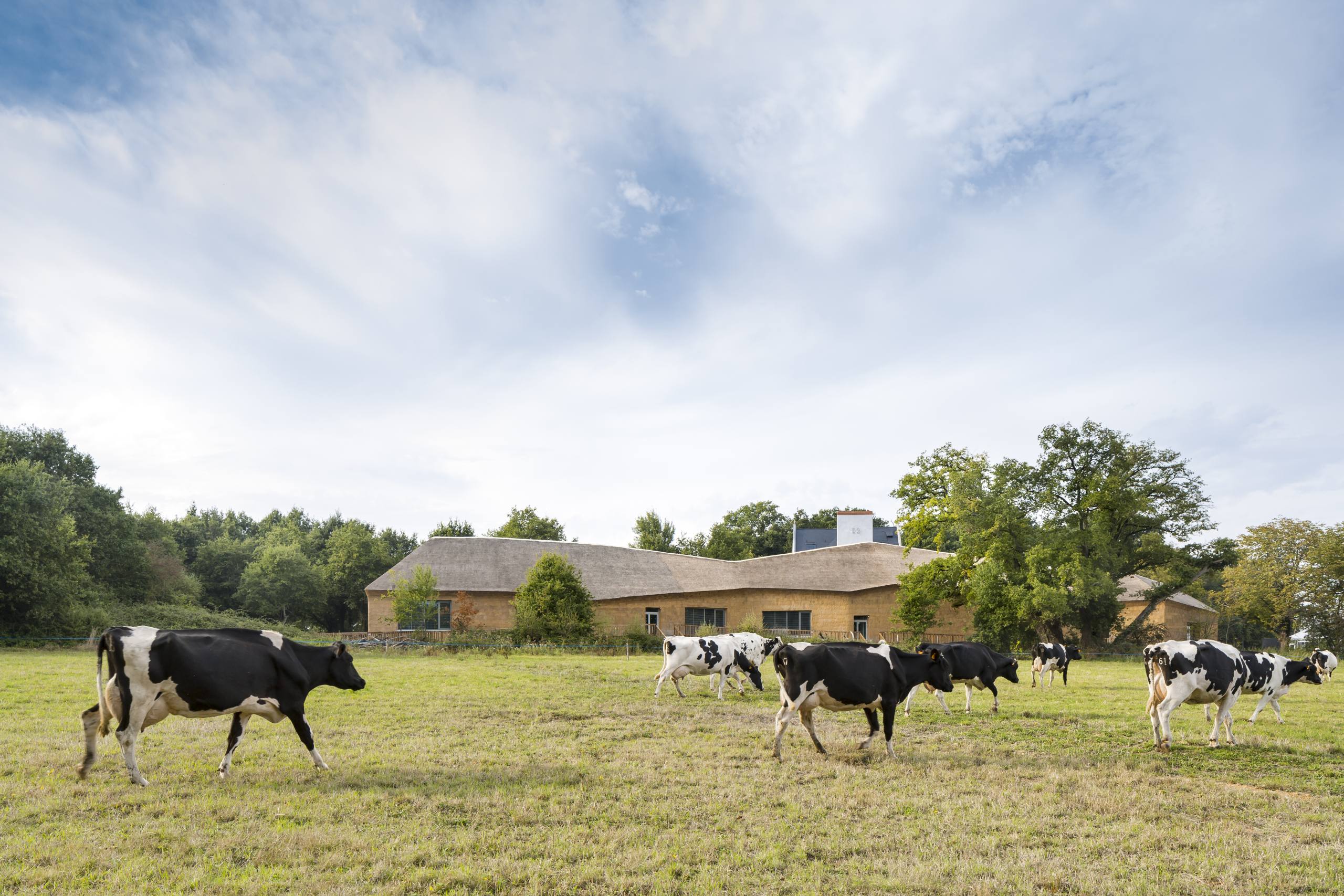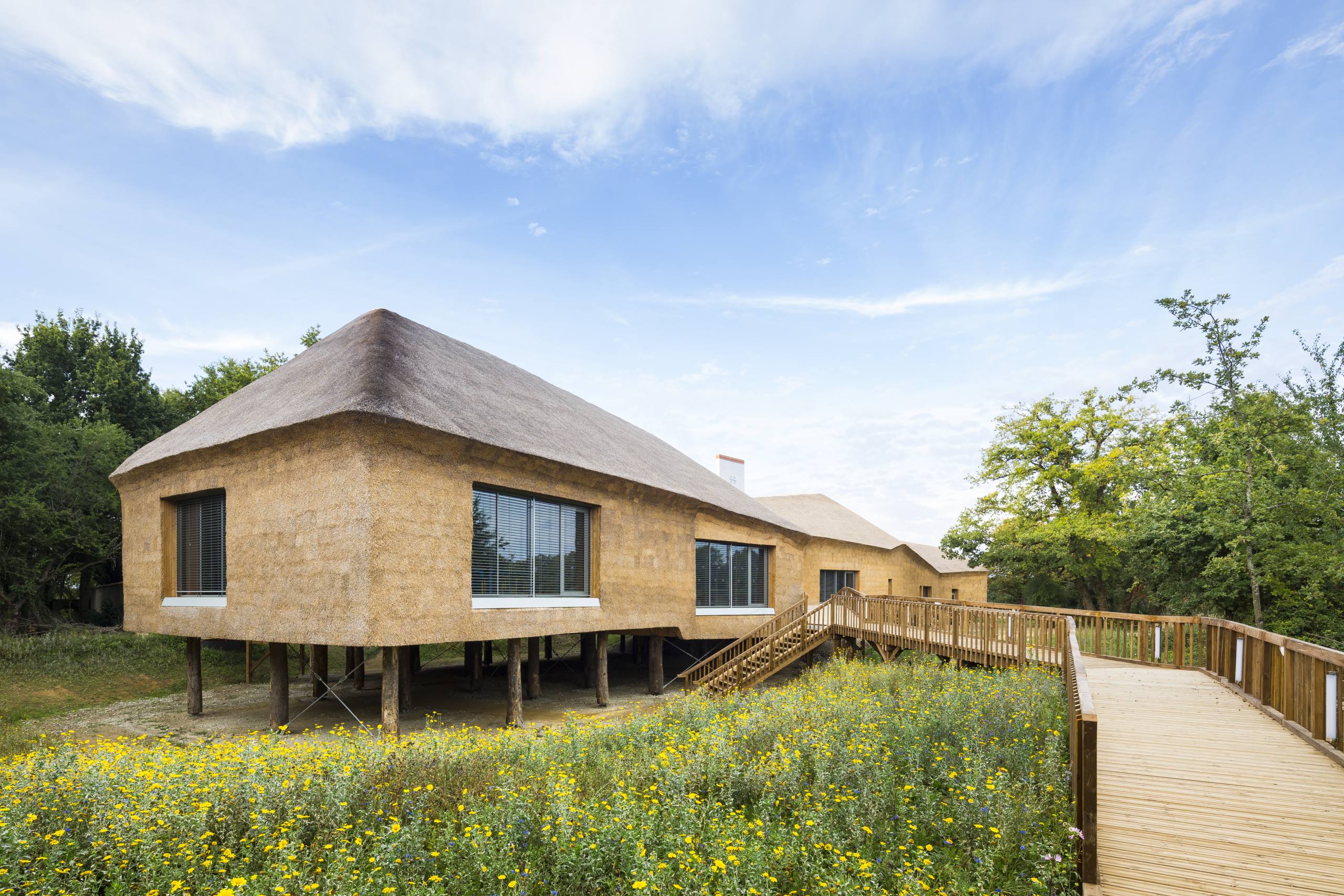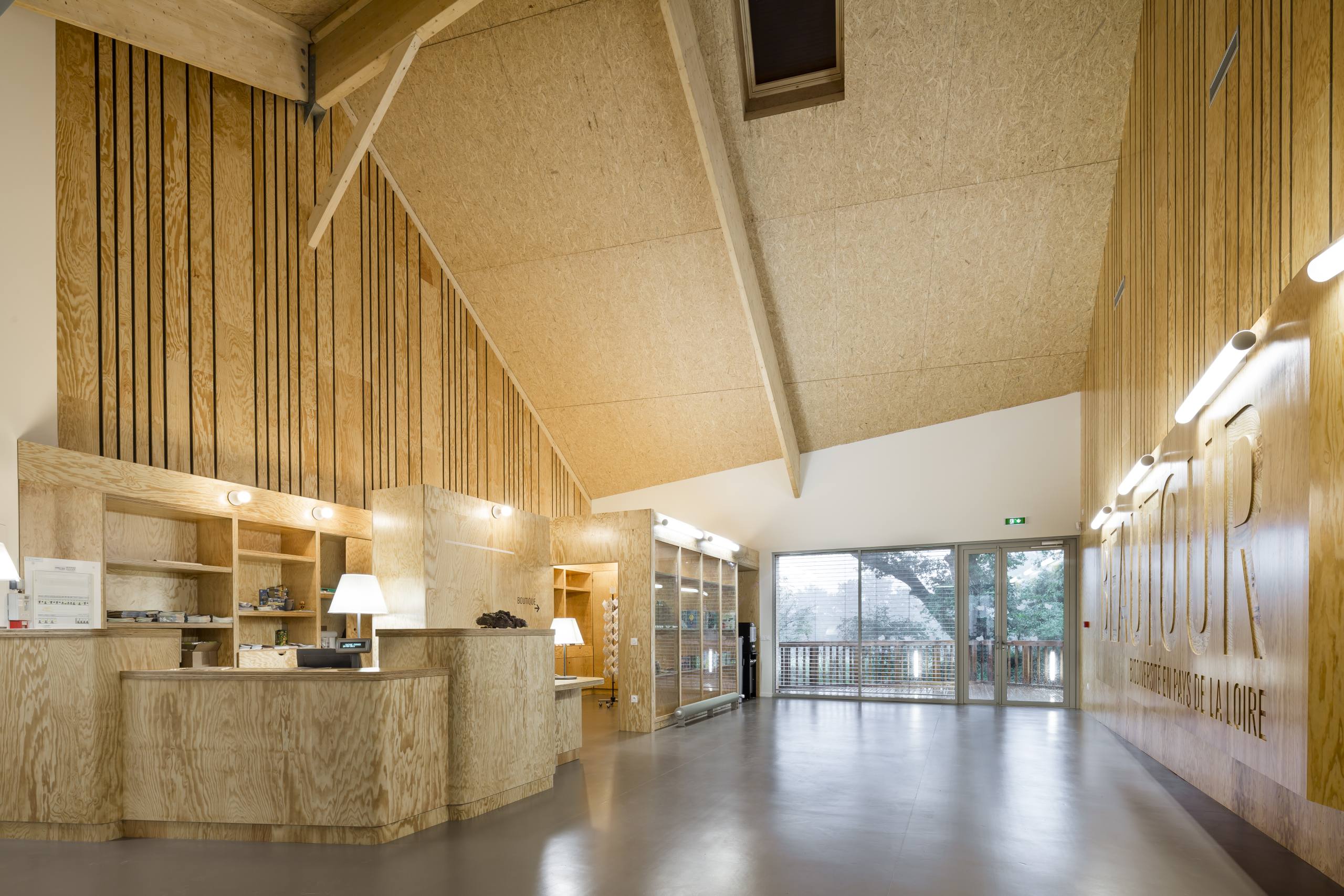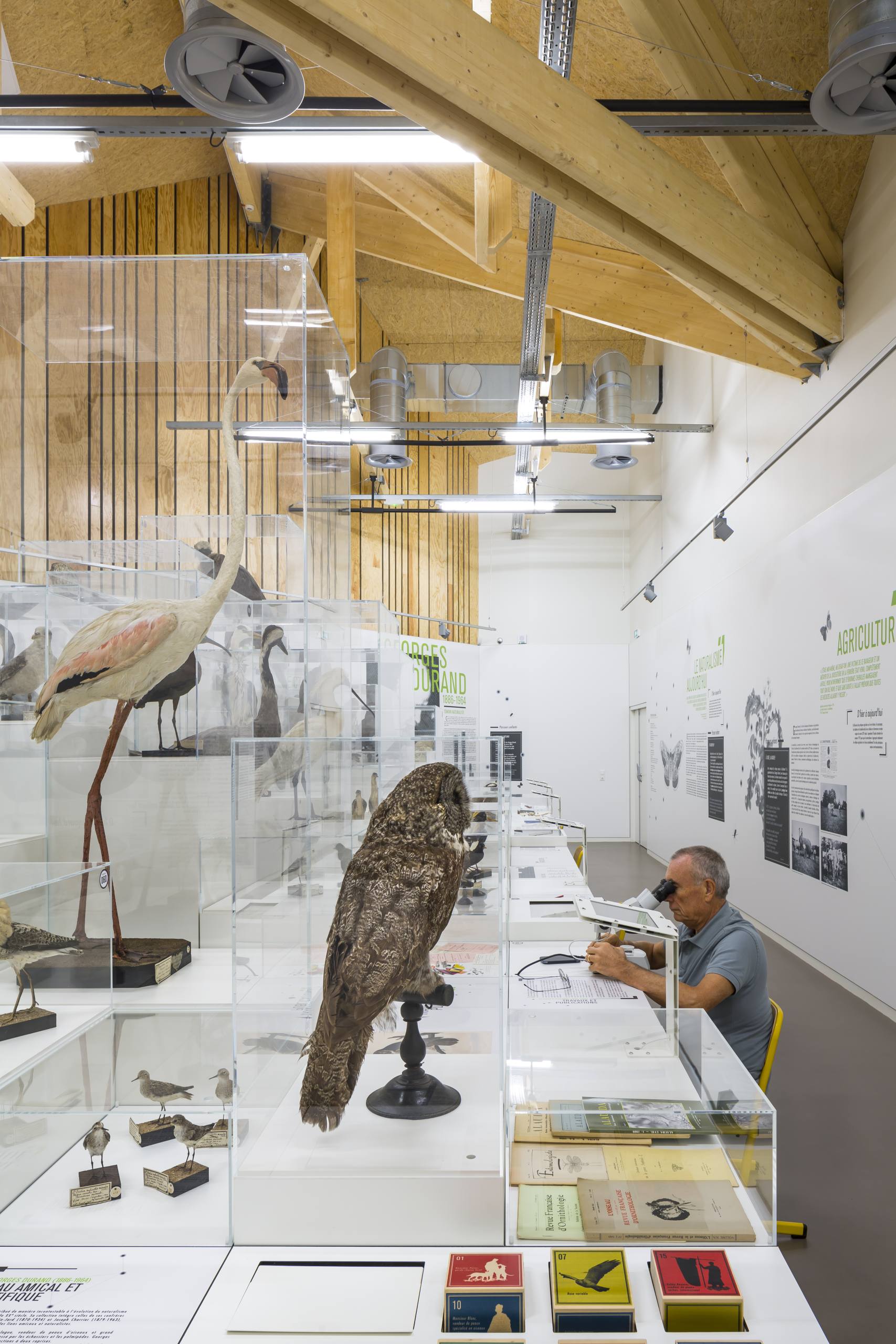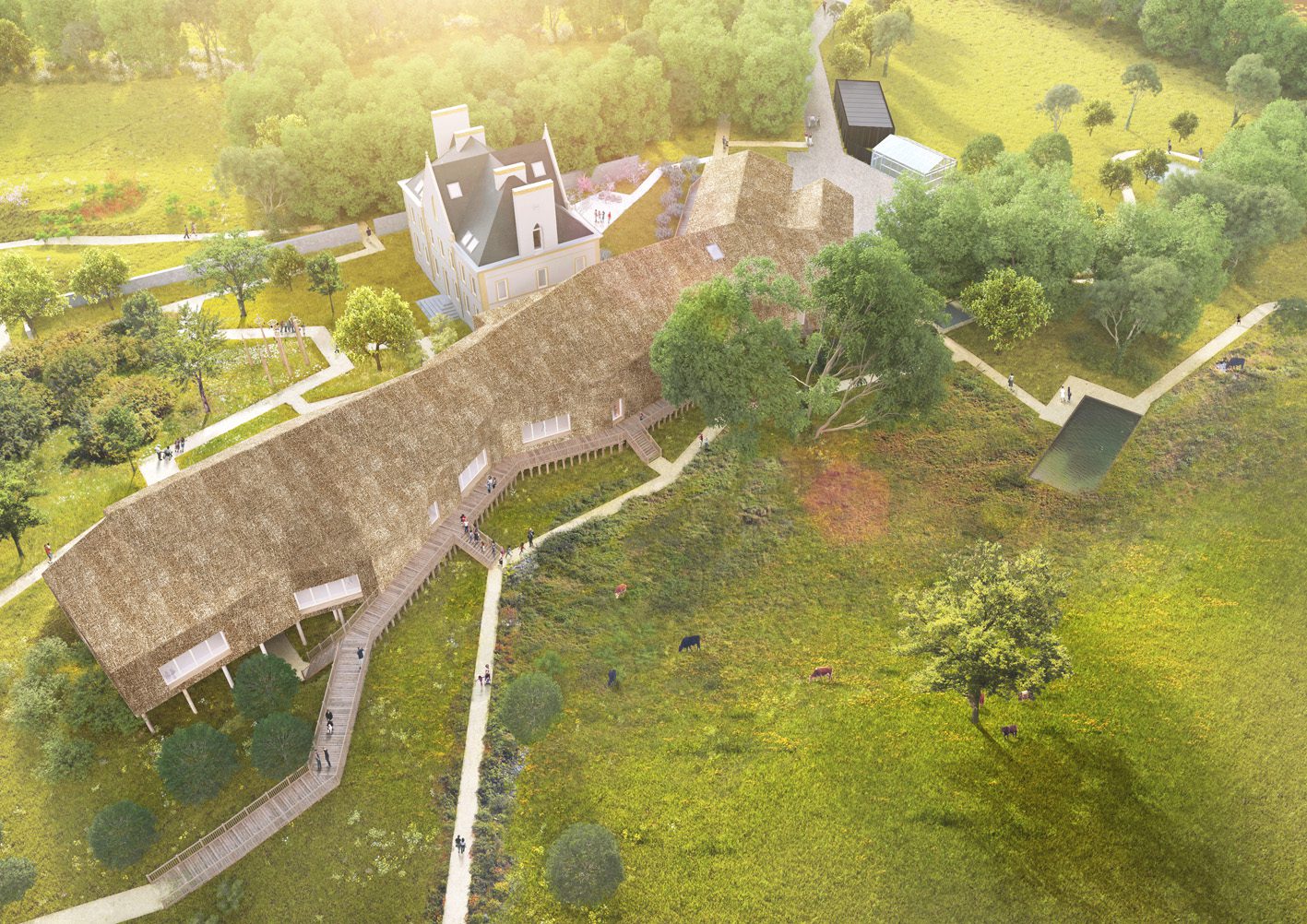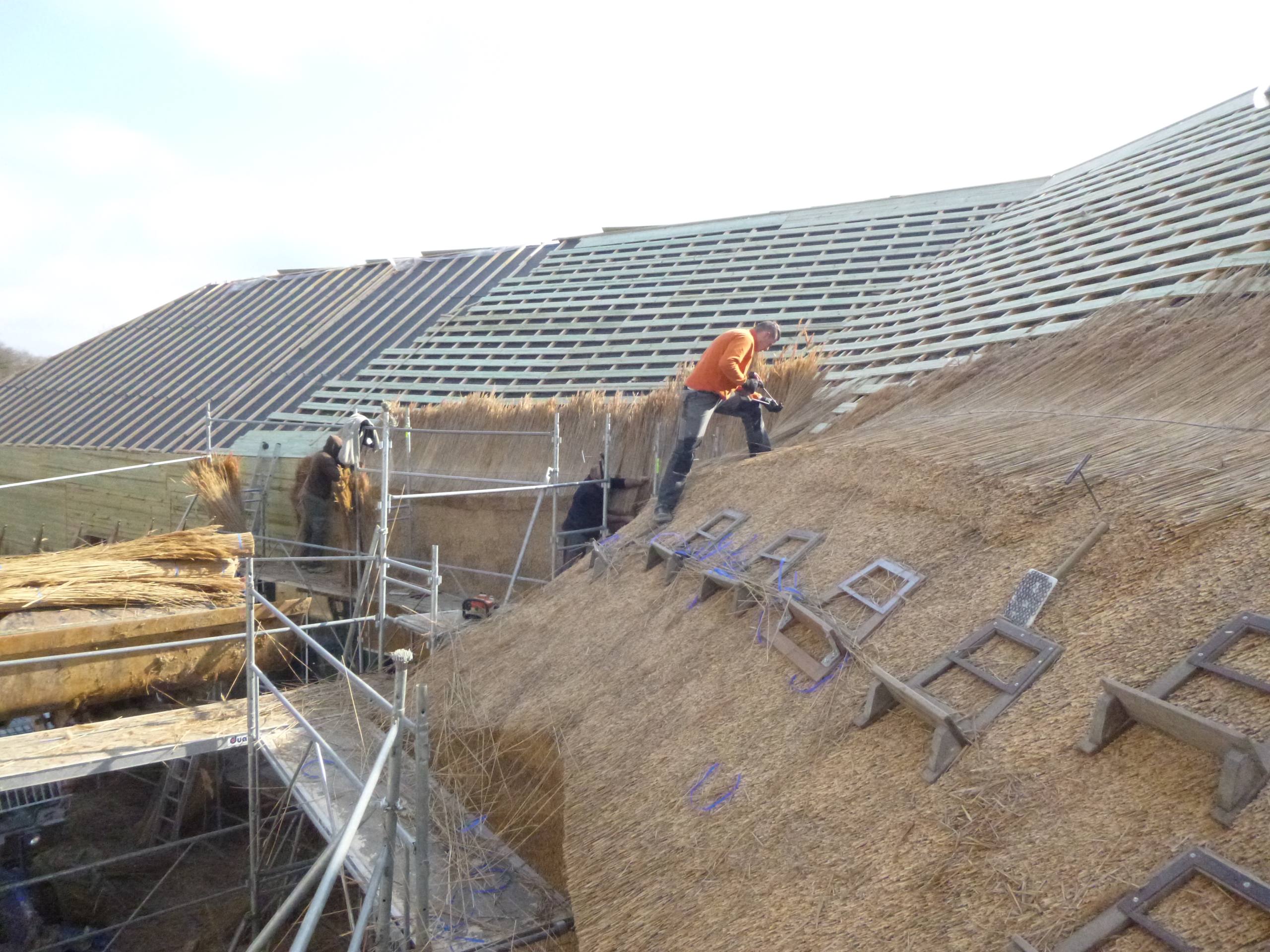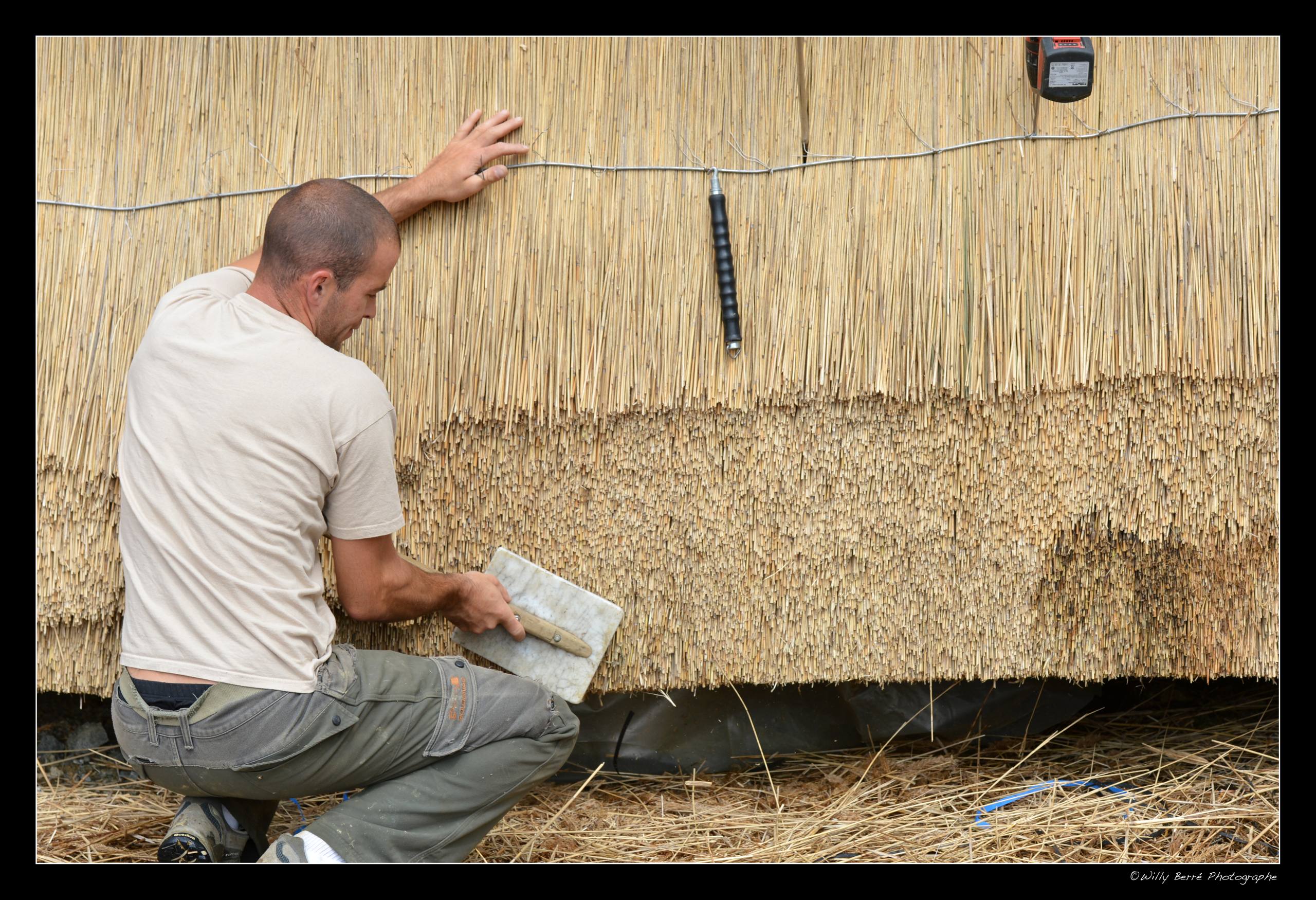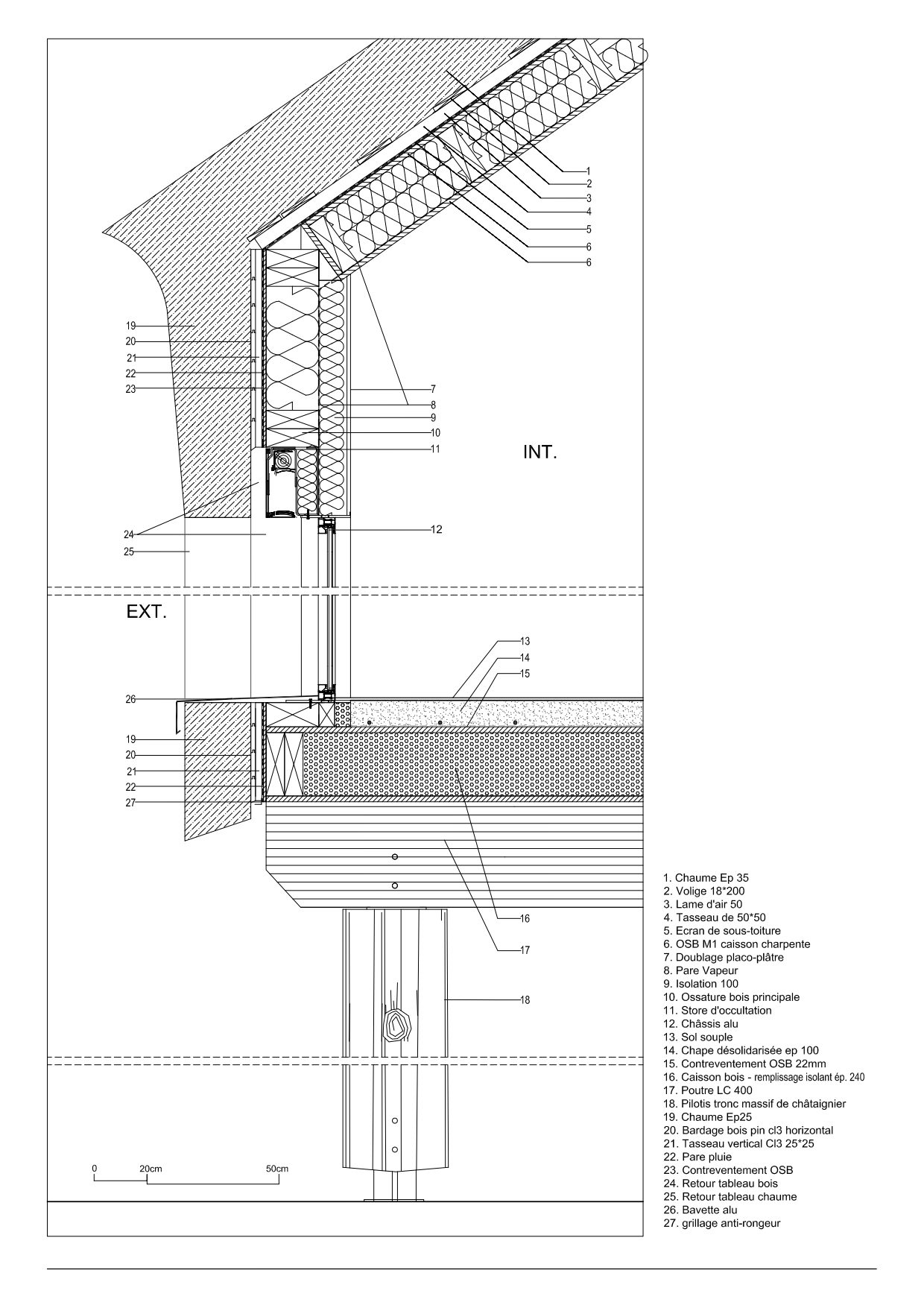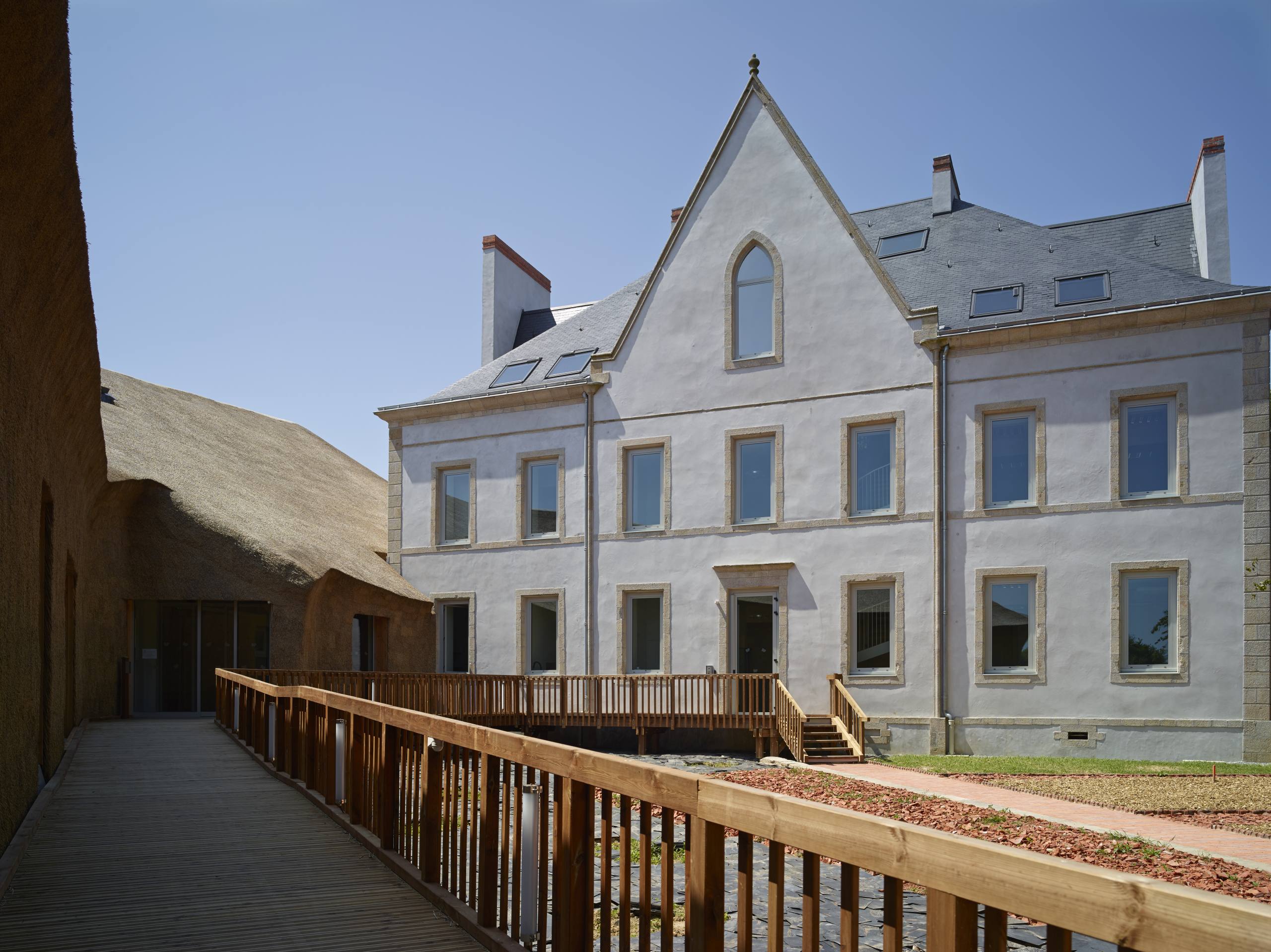Museum & Biodiversity Research Center, La Roche sur Yon/
Guinée*Potin Architects
Project Details

Location(City/Country):
Beautour, La Roche sur Yon / France
Tipology:
Cultural
Year (Design/Construction):
- / 2013
Area (Net/Gross):
- / 2057 m2
Operational Carbon emissions (B6) kgCO2e/m2/y:
-
Embodied Carbon emissions (A1-A3) kgCO2e/m2:
-- Extensive use of local and natural resources, including a traditional thatched skin, that provides a continuous envelope.
- Off-site manufactured timber frame, allowing a clean construction site and a low environmental disturbance.
- Light impact on the surroundings by raising the building on wood stilts, reducing the impact of the foundations.
- South façade, generously open on the landscape, and circulations concentrated on the north side.
- Light touch refurbishment of the existing Mansion, maintaining most of the original elements.
The main idea of the Beautour center is to glorify the historic mansion of Georges Durand, a Vendean naturalist (1886 – 1964) and his important collections. Man of rights and politics, he quickly developed a passion for natural sciences. For 70 years, he collected plants and insects from all over Europe, with the help of his friends and fellow scientists. This is how he has been able to collect nearly 5.000 birds, 150.000 butterflies and insects, and numerous herbariums. Thus almost all 4.500 species of the french flora are hereby represented.
Context
The aim of the project is to develop educational and scientific supports themed on biodiversity, as well as a management strategy and evolution prospectives for the whole area. Beyond the thematic gardens, composting, and using rainwater for watering, that are some obvious actions, the project aims to help new forms of biodiversity to develop in this area, deserted for 30 years. Some plots of land have reached a state of «climax», and an intervention is to choose between two alternatives : either an integral preservation, or a minimal intervention that could engage a new natural diversification. Some other plots, on the contrary, have been maintained in a state of biological poverty due to frequent mowing and pasture. These ones could use a higher level of interventionism, in order for a new ecosystem to settle on a long term basis.
Biodiversity
The Museum & Biodiversity research center tries to find a right balance between light actions, preserving the biodiversity already on site, and other stronger actions, creating a positive impact on the biological diversity. Thus the project is neither a theme park, nor an ornamental garden. This really is a site-specific project, inspired by the local biodiversity, the topography, and the other qualities that are proper to Beautour. The visit itinerary is drawn by this logic, scientific purpose leading the visitor down to the fields and the valley, where the wild nature meets both Beautour historical and newly designed gardens and meadows.
Architectural project
In a very present landscaped green setting, the project takes on a strong identity, reinterpretation in a contemporary and innovative way a traditional technique, by adopting a thatched skin, entirely covering both walls and roof of the building. The competition images display the natural aging of the material, fading to grey tones and shades changing as the seasons pass by. As a compact shape would have vied with Mr Durand’s mansion, the building grows organic, embracing the mansion, surrounding it and spreading on the site without overthrowing the natural order. Solid raw chestnut stilts also confuse the overall image of the project, mimetic in this very context. The building, as a branch laying on the ground, is a ‘piece of built landscape’, a ‘new geography’ completing the natural scenography. Letting the building rise up the ground allows the biodiversity to stay in place and minimizes the impact of foundation works. The project slowly lifts up to unveil the pond hosting frogs and herons. The technical facilities annex is painted black and houses locker-rooms and a wood-fired boiler. A pedagogical greenhouse stands next to it at the entrance of the site.
Global approach : how to combine bioclimatic design and contextual approach
A bioclimatic approach seems obvious considering the program (environment and biodiversity are the leitmotiv words), and would concentrate on being as compact as possible, in order to prevent thermic loss. But in the context of Beautour, where the mansion (even in ruins) stands quite impressive from the first visits, it has been chosen not to go in this way and add a second massive building, but instead to design a stretched shape, laying on over 100 meters.
This contextual approach compensates, from our point of view, the ideal of the bioclimatic shape, and the following principles :
– Light impact on the surroundings by using natural thatch and raising the building on stilts, lowering the impact of foundation works
– Solar south façade, generously open on the landscape, and circulations concentrated on the north side
– Maximal in-factory prefabrication phase, allowing a clean construction site and a low environmental disturbance
Structure & materiality
Given the will to protect the existing ground and minimize concrete foundations, the extension is built on a prefabricated timber frame, allowing a control during the fabrication with high precision assembly techniques, and a high internal flexibility in the future. The use of a mixed wood floor and concrete screed compensates for the low inertia of the timber structure. Heath is kept inside in winter, but the thatched roofs and walls (35cm on roofs, 25cm on walls) prevents its penetration in summer. Concerning the existing mansion, it is rehabilitated in a patrimonial way : restoration of all windows, floors and timber frame, exterior walls are coated with a light gray lime plaster. Inside the mansion, existing floors have been conserved and original cement tiles have been relocated and mixed with contemporary pieces to create an ambiguity on what is and what has been.
Orientation
On the south façade, the pronounced thatch overhang, in association with the existing deciduous trees hedge, prevents overheating during summer, and provides a visual comfort all year long. In the restored building, the width of the walls and the insulation panels (90 cm combined) and the position of the windows (aligned with the insulation) create a solar protection from direct sunlight during summer months.
The inner organization of the project clearly articulates the different units from a generous entrance hall that distributes the various elements along a north side circulation. The main hall is open on south and north, and is part of a scenographied route that initiates on the parking lot. The sequence begins with a 200 meters path going through the willow labyrinth and continues on the original footpath leading to the mansion. This one has been conserved in its original state and is reserved to pedestrians.
Lobby hall
At the end of the footpath, a wooden ramp leads the visitor toward the thatched building entrance, walking alongside the exhibition rooms on his left, and discovering Mr Durand’s mansion on his right. The lobby hall, with south and north views, articulates all the different spaces and is part of the pedagogical itinerary. It offers the visitors a comfortable 9 meters high space, letting them see the timber frame and the wood panels bearing the roof. It opens on a south-oriented terrace and outdoor footbridges leading to the pond.
Exhibition rooms
Occupying the north part of the thatched volume, the two exhibition rooms (permanent and temporary) are accessible by the main hall. Their thatched gables are visible right from the entrance of the site.
The permanent exhibition aims to draw the evolution of the naturalists work, through the example of more than 80 pieces from Mr Durand’s collection. Academic and associative partners have been working together on the scientific content.
The exhibition is built around 3 main themes that frame the visit :
– Naturalist theme : techniques, methods, works and evolution are explored and related to the history of the naturalism during the twentieth century
– Landscape theme : Mr Durand explored various scales of landscapes : from Beautour and its surrounding swamps in Vendée, to the Pyrénées, France and Africa, from a plot of land to a continent. Collections are then related to their territories by the study of scales, backgrounds, habitats, that allow the visitor to relate naturalized animals to their territory through the notion of biodiversity
– Biographical theme : the exhibition enlights the contributions Mr Durand has made to the knowledge in the naturalist field and its expansion in the twentieth century, as well to the local history and heritage
A large exhibition table occupies the middle of the space, divided following a grid refering to entomological framed butterflies. Various height modules create an imaginary topography, suggesting the diversity of the prospection sites, and able to display a large number of specimens. The contents feature naturalized specimens, scientific and historic explanations, objects to discover, touchpads, and augmented reality games.
The temporary exhibition «Agriculture and biodiversity» explores the different relationships between agriculture and biodiversity from a landscape point of view : common point between these two entites, landscape is a familiar spatial notion and lets the visitor rediscover the subject through its various scales and interactions. Landscape is straightaway present in the exhibition room through the wide window, opening on the meadows and framing the natural grove. The exhibition organizes from this direct visual link, and guides the visitor in observing and reading the various landscapes of the region. On two lateral walls, 6 different regional characteristic landscapes are featured. In the middle of the room, an interactive map invites the visitor to trail around these landscapes, locate them in the region, by activating different layers and thus discovering the connections between every component.
The existing mansion
Visiting the old house and feeling the particular atmosphere of the place led us to completely rehabilitate the mansion, conserving this beautiful heritage from the past and taking advantage of the generous volumes of the building. We decided to keep a domestic atmosphere in the mansion, thus the first floor hosts the associative spaces, and the second floor hosts the research laboratories. Researchers can enjoy large views on the horizon through the main façade ribbed windows, or framed views on the extension thatched roof. This floor is kept widely open, and the original centenarian timber frame (preserved at 50%) is exposed and visible. The ground floor is directly connected to the entrance hall created in the extension, and hosts shared spaces and offices. One one hand, the mansion plays a historic role, it is a memory from the past (wooden floors, ciment tiles and granite paving are conserved). On the other hand, the new extension and contemporary pieces reactivate the mansion in a whole new living dimension.
The educational rooms
On the west side of the extension, a conference room, a lunch room, and two educational rooms take place between a hedge on the south, the abandoned garden transformed in an ‘insects field’ on the north, and an existing wall on the west. From the entrance hall, raised 1.20m above the ground, a slight ramp (5%) serves these particular spaces, differentiating from the common spaces by this level difference. On the west end, the educational room rises 3.5m above the natural ground, offering a panorama on the landscape and the pond.
- Client: Région des Pays de la Loire
- Architect in charge: Agence GUINEE*POTIN Architectes
- Design team: Anne-Flore Guinée et Hervé Potin architectes; Solen Nico chef de projet
- Landscape design: Guillaume Sevin Paysages
- Scénography: BLOCK Architectes
- Graphic design: WARMGREY
- Museographic content: Stéphanie VINCENT
- Engineering: ISATEG (structure / fluides), ITAC (acoustique)
- Photography: Sergio Grazia.
- French eco-label «BBC – Effinergie classe A» (Low consumption building)
- PEQA Label (Performances Energétiques et Qualités associées)
- Airtightness < 1.2 m3/ h / m2
- Heating mode : wood pellet boiler
